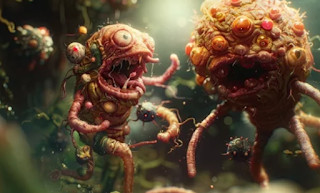Bock and colleagues (2024) give us a fascinating glimpse into the world of short-chain fatty acids, signaling molecules our gut bacteria produce during dietary fiber fermentation
. These aren't just waste products; they're potent messengers with a wide range of benefits for gut health and, potentially, overall well-being.
The SCFA Production Powerhouse: Your Gut Microbiome
Imagine a bustling factory inside your gut. Fueled by dietary fiber, this factory is run by trillions of resident bacteria forming your gut microbiome. As these microbes break down complex carbohydrates, they churn out SCFAs, including acetate, propionate, and butyrate (Bock et al., 2024). These aren't byproducts; they're strategically produced signaling molecules crucial in keeping your gut healthy.
The Diverse Workforce: Key Players in SCFA Production
Several friendly bacteria deserve a standing ovation for their role in SCFA production, and these Allstars include (Bock et al., 2024):
- Lactobacillus: Renowned for its probiotic properties, Lactobacillus species are abundant in yogurt and fermented foods. They are critical producers of lactate, which some other gut bacteria then convert into beneficial SCFAs.
- Bifidobacterium: Another group of probiotic bacteria, Bifidobacterium, is particularly adept at producing acetate and propionate. They are commonly found in fermented foods and some infant formulas.
- Akkermansia Muciniphila: This fascinating bacterium thrives on mucin, the primary component of mucus lining your gut. Akkermansia helps maintain a healthy gut barrier by breaking down mucin and stimulates butyrate production by other bacteria.
- Faecalibacterium Prausnitzii: This bacterium is a champion for gut health. It produces butyrate, the most potent anti-inflammatory SCFA, and contributes to a balanced gut environment.
- Many Others: The human gut microbiome is a diverse ecosystem, and many other bacterial species contribute to the overall SCFA production.
SCFAs and Metabolic Health: A Promising Connection
Research suggests a fascinating link between SCFAs and metabolic health, potentially influencing how our bodies regulate energy and blood sugar (Bock et al., 2024):
- Signaling Through Special Receptors: SCFAs act as chemical messengers, binding to particular G protein-coupled receptors (GPCRs) on various body cells. This triggers a cascade of events influencing metabolism, like regulating blood sugar levels and fat storage.
- Improved Insulin Sensitivity: Studies suggest that SCFAs may improve how our bodies use insulin, the hormone responsible for shuttling glucose from the bloodstream into cells. This can reduce the risk of insulin resistance, a precursor to type 2 diabetes.
- Reduced Inflammation: Chronic, low-grade inflammation is linked to various metabolic issues. By reducing inflammation in the gut and potentially throughout the body, SCFAs contribute to better overall metabolic health.
Beyond SCFAs: Other Gut metabolites join the Chorus.
The gut produces a symphony of metabolites, not just SCFAs, and here are some other noteworthy players that contribute to the overall health conversation (Bock et al. 2024):
- Succinate: This metabolite may enhance gut barrier function and reduce inflammation, potentially protecting against inflammatory bowel disease (IBD).
- Indole Derivatives: These molecules produced from the breakdown of the amino acid tryptophan can strengthen the gut barrier and enhance immune function.
- Microcins: These antimicrobial peptides produced by gut bacteria help maintain gut health by keeping harmful bacteria in check, promoting a balanced gut environment.
A Deeper Dive: The Complexities of SCFA Research
While the research on SCFAs and other gut metabolites is promising, there's still much to learn, according to Bock and colleagues (2024):
- Optimal Doses: Determining the ideal SCFA concentrations for maximum Health benefits remains an area of active investigation. More research is needed to understand if there's a specific ratio of different SCFAs that yield the most significant health advantages.
- Personalized Approaches: Future research has the potential to personalize dietary and probiotic interventions to optimize SCFA production for individual needs. Imagine a future where we can tailor our gut health strategies based on our unique microbiome composition and health goals.
The Takeaway: Nourishing Your Gut for Overall Well-Being
By supporting a healthy gut microbiome with a fiber-rich diet and potentially through probiotics, we can encourage the production of beneficial SCFAs and other metabolites. This can contribute to a strong gut barrier, reduce inflammation, and improve our overall metabolic health. The future of gut health research is exciting, with the potential to harness the power of these tiny metabolites for even greater well-being.
References
- Bock, Patrícia & Martins, Andreza & Schaan, Beatriz. (2024). Understanding How Pre- and Probiotics Affect the Gut Microbiome and Metabolic Health. American journal of physiology. Endocrinology and metabolism. 10.1152/ajpendo.00054.2024.




















